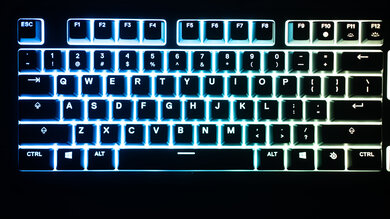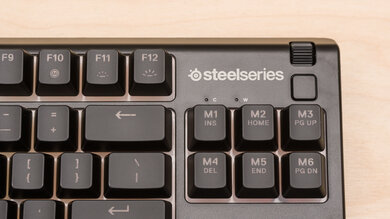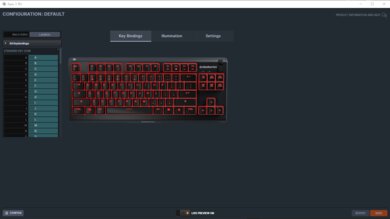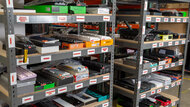The SteelSeries Apex 3 TKL is an entry-level gaming keyboard with rubber dome switches. It's a smaller version of the SteelSeries Apex 3, and it's one of the few non-mechanical gaming keyboards available in a TenKeyLess size, providing you extra space on your desk to move your mouse around since it doesn't have a numpad. It's also certified to be IP32 rated, meaning it's resistant to some liquid, so you shouldn't have to worry about damaging it if you spill your drink. All keys are macro-programmable through the new SteelSeries GG software, and it has RGB backlighting, but the keys aren't individually lit, so you only have eight customizable zones.
Our Verdict
The SteelSeries Apex 3 TKL is decent for gaming. The rubber dome switches are fairly light to press, but they have a long pre-travel distance. All keys are macro-programmable, and it has RGB backlighting, but the keys aren't individually lit, so you can only customize the lighting to 8 zones. Sadly, the latency is high for competitive gamers, but it should be fine for casual gamers.
-
All keys are macro-programmable.
-
Rubber dome switches are light to press.
-
RGB backlighting.
-
Latency isn't ideal for competitive gaming.
-
Backlight customization is by zones only.
-
Lack of wrist rest.
The SteelSeries Apex 3 TKL is a wired-only keyboard that isn't designed for use with mobile devices.
The SteelSeries Apex 3 TKL is decent for office use. The keys are stable, and the rubber dome switches provide decent typing quality with tactile feedback. Sadly, the ABS keycaps feel slippery, and it doesn't come with a wrist rest, but you still shouldn't feel too much fatigue. Also, it's wired-only, so you can't connect with your mobile devices.
-
Rubber dome switches are light to press.
-
Decent typing quality with stable keys.
-
Lack of wrist rest.
-
ABS keycaps feel slippery.
The SteelSeries Apex 3 TKL is okay for programming. You can reprogram and set macros to any key, and it has decent typing quality as the keys feel stable. Its ergonomics are just alright as it doesn't come with a wrist rest. It's good to use in a dark environment because it has RGB backlighting, but it's zone-lit with only eight customizable zones.
-
All keys are macro-programmable.
-
RGB backlighting.
-
Decent typing quality with stable keys.
-
Backlight customization is by zones only.
-
Lack of wrist rest.
-
ABS keycaps feel slippery.
The SteelSeries Apex 3 TKL is disappointing to use with a home theater PC setup, but it's not designed for this use. It's wired-only, so you have to connect directly to the TV, and it lacks a trackpad. Still, it has RGB backlighting and dedicated media keys.
-
RGB backlighting.
-
Backlight customization is by zones only.
-
Wired-only design.
-
No trackpad.
- 7.2 Gaming
- 4.0 Mobile/Tablet
- 7.2 Office
- 6.8 Programming
- 4.7 Entertainment / HTPC
Changelog
- Updated Oct 05, 2022: Added a comparison to the recently reviewed SteelSeries Apex 9.
- Updated Oct 28, 2021: Review published.
- Updated Oct 26, 2021: Early access published.
- Updated Oct 25, 2021: Our testers have started testing this product.
- Updated Oct 21, 2021: The product has arrived in our lab, and our testers will start evaluating it soon.
Check Price
Differences Between Sizes And Variants
We tested the SteelSeries Apex 3 TKL, which is essentially a smaller version of the SteelSeries Apex 3 and doesn't come with a wrist rest. Our results are valid for the TKL version only, but check out the review for the full-size variant if you want to see how it performs.
If you have an Apex 3 TKL that performs differently from ours, let us know, and we'll update the review. You can see the label for our unit here.
Compared To Other Keyboards
The SteelSeries Apex 3 TKL is a decent gaming keyboard with rubber dome switches. It's a nice option if you don't like mechanical switches and want a TKL size keyboard. It's similar to the SteelSeries Apex 3, except it doesn't come with a wrist rest, but choosing one over the other comes down to size preference. It also offers better typing quality than other non-mechanical gaming keyboards, but its latency is a bit high.
See our recommendations for the best keyboards for programming, the best gaming keyboards under $100, and the best RGB keyboards.
The SteelSeries Apex 3 is essentially a bigger version of the SteelSeries Apex 3 TKL, but there are a few differences. The Apex 3 has a numpad, and it comes with a wrist rest for better ergonomics. However, typing feels the same on each because they use the same rubber dome switches. They each have zone-lit RGB lighting, but the Apex 3 has ten customizable zones due to its bigger size compared to the TKL's eight zones. The TKL version uses the new SteelSeries GG software, which includes the Engine software that the Apex 3 uses. Other than that, both keyboards are very similar.
The Razer Huntsman Mini is a much better gaming keyboard than the SteelSeries Apex 3 TKL, but they're different types of keyboards. The Razer is a compact 60% mechanical keyboard that's smaller than the TKL-size SteelSeries Apex TKL, which has rubber dome switches. The Razer Optical switches available with the Razer keyboard provide a lighter and quicker gaming experience, and it has lower latency. The Razer also has individually lit keys, while the SteelSeries is limited to 8 zones of customizable RGB.
The Logitech G213 Prodigy and the SteelSeries Apex 3 TKL are both decent gaming keyboards. They both have similar rubber dome switches, but the ones on the Logitech are lighter to actuate. The Logitech is bigger, so it comes with a numpad, it has a wrist rest, and it has much lower latency for a more responsive gaming experience. On the other hand, the SteelSeries feels better built, and the keys are more stable, providing better typing quality. Also, you can reprogram any key on the SteelSeries while you're limited to just the function keys on the Logitech.
The Razer BlackWidow V3 is better for gaming than the SteelSeries Apex 3 TKL. The Razer is a full-size keyboard available with two types of mechanical switches, while the SteelSeries is TKL and has rubber dome switches. However, the Razer is also available in a TKL size, and the SteelSeries has a full-size variant as well. The mechanical switches on the Razer provide a better gaming and typing experience, and the keyboard has much lower latency. It also has better ergonomics because it comes with a wrist rest, and it has individually lit RGB backlighting, while the SteelSeries is limited to 8 lighting zones.
The Corsair K55 RGB and the SteelSeries Apex 3 TKL are two decent gaming keyboards with rubber dome switches. While the Corsair has much lower latency for a more responsive gaming experience, the keys on the SteelSeries feel lighter to press and offer decent typing quality. They're similar in terms of gaming features, but the Corsair also comes with a wrist rest, which the SteelSeries doesn't, and it's bigger as it has a numpad.
The SteelSeries Apex 3 TKL and the SteelSeries Apex 9 are both wired-only TenKeyLess gaming keyboards. The Apex 9 performs much better overall as it has very low latency and very sensitive mechanical switches. The Apex 3 TKL uses rubber dome switches, which feel mushier and not as satisfying, and its latency is significantly worse.
The SteelSeries Apex 7 TKL is much better than the SteelSeries Apex 3 TKL. The Apex 7 TKL is a mechanical keyboard available in three types of switches, while the Apex 3 TKL has rubber dome switches, which feel heavier. The Apex 7 TKL has lower latency, offers better typing quality, and feels better built. It also has better ergonomics because it has a wrist rest. Lastly, the Apex 7 TKL has individually lit RGB keys, while the Apex 3 TKL is limited to zone lighting.
The Razer Cynosa V2 is better for gaming than the SteelSeries Apex 3 TKL. They each have rubber dome switches, and the ones on the Razer are lighter to press and have a shorter pre-travel distance than those on the SteelSeries, which is a big reason why it's better. Also, the Razer has individually lit keys, while the SteelSeries is limited to zone lighting. However, the SteelSeries offers better typing and build quality because the keys feel more stable and less mushy. The SteelSeries is also smaller, so there's more space on your desk for your mouse, but that means it doesn't have a numpad.
Test Results
The SteelSeries Apex 3 TKL is a smaller version of the SteelSeries Apex 3, so it takes up less space on your desk.
The build quality is good. The frame and base plate are both plastic, and even though the keyboard flexes when you twist it, it still feels solid, and it shouldn't present too many problems during regular use. The doubleshot ABS keycaps feel slippery, but the keys are stable, and there isn't much wobble. There are five rubber feet underneath, including the incline feet, to hold it in place. The keyboard is also IP32 rated, meaning it's water-resistant to small spills from an angle. Overall, for an entry-level keyboard that's entirely plastic, it's well-built.
The SteelSeries Apex 3 TKL has okay ergonomics. It has an incline setting like the SteelSeries Apex 3, but it feels like it would benefit from a wrist rest, which it doesn't come with, and there isn't one you can buy separately from the SteelSeries website either.
The SteelSeries Apex 3 TKL has zone-lit RGB backlighting with eight zones that you can customize. It does a good job displaying pure white, but it looks more blue in person than in the photo above.
The cable is a standard rubber wire and isn't anything special.
The SteelSeries Apex 3 TKL has a few extra features to improve the user experience. All keys are macro-programmable either through the dedicated software or directly on the keyboard using the Macro button. It has dedicated media keys with the volume wheel on the top right, and the unmarked button below it is Play/Pause.
The SteelSeries Apex 3 TKL uses rubber dome switches, which SteelSeries labels as 'Whisper Quiet Switches'. The pre-travel distance is a bit long, and they require some force to get over the tactile bump, but they're not heavy overall. If you're interested in a similar unit with upgraded optical switches, check out the SteelSeries Apex 9.
The typing quality is decent. There's good spacing between the keys, and they feel stable, with minimum wobble even on the larger keys. The switches aren't as mushy as some other rubber domes, and they provide nice tactile feedback. It feels like it could benefit from a wrist rest, but you shouldn't feel much fatigue during long typing sessions. You shouldn't feel like your typing speed is decreased, either. The one downside to this is that the ABS keycaps feel slippery.
Like the SteelSeries Apex 3, the latency is decent. It's fine for most gamers, but competitive gamers may notice a delay. You won't notice any problems during regular typing use.
The dedicated software is the new SteelSeries GG software, which includes the Engine program once you launch it. From there, you can reprogram key bindings and customize the backlighting. It doesn't have onboard memory, but you can save profiles in the software.
The SteelSeries Apex 3 TKL works with the three major desktop operating systems. On macOS, the Insert key registers as Help, and the SteelSeries button doesn't work. The software isn't available on Linux, and the Pause button doesn't work.
Comments
SteelSeries Apex 3 TKL: Main Discussion
Let us know why you want us to review the product here, or encourage others to vote for this product.


































